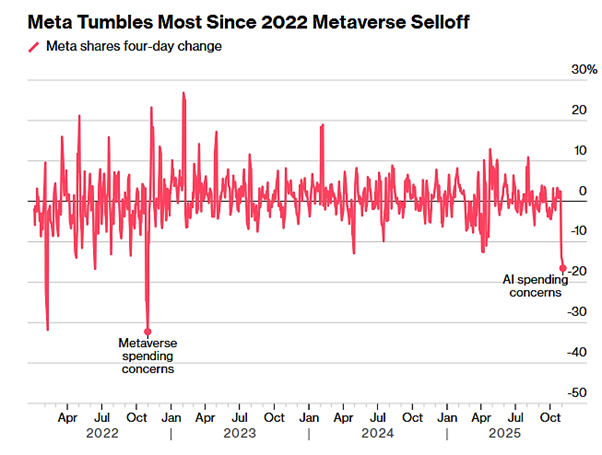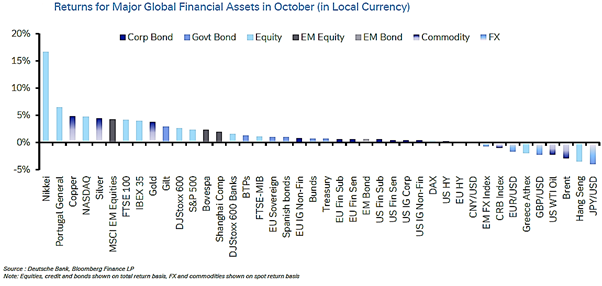Key Themes – Tech Wobbles, AI Euphoria Fades, Bitcoin Drops, Crypto Sentiment Sours
October was another reminder that markets can appear calm on the surface but fragile underneath. Headline equity indices eked out modest gains, and bond markets rallied on the back of softer inflation data. But beneath the surface, dispersion rose, conviction fell, and sentiment around technology and crypto assets shifted sharply.
US tech stocks faltered in the second half of October, with Meta falling nearly 20% after warning on the scale of its AI capex programme. Markets that had cheered the ‘AI arms race’ narratives began to question the return on investment, particularly as user growth plateaued and monetisation lagged expectations. As the graph below shows, a similar experience impacted Meta in 2022. SCM/MoneyShe has very low exposures across its portfolios to Meta and the other so-called Magnificent 7 stocks.

Meanwhile, Nvidia and other AI hardware beneficiaries saw heightened volatility, while valuation multiples across the sector remain near historic extremes. Outside the US, concerns around AI saturation and infrastructure constraints also grew. European data suggested ChatGPT subscriptions have flatlined since May, and sentiment around AI adoption is weakening in several key verticals. Investors are beginning to reassess whether AI can deliver both growth and margin expansion at the current scale.
Another sign of shifting risk appetite came from crypto markets. Bitcoin has fallen by over 27% since its early October high. While some of the weakness was linked to ETF outflows, broader concerns about the lack of real-world adoption, regulatory headwinds, and waning enthusiasm around blockchain infrastructure have weighed on sentiment. The decline in crypto assets, which are often seen as proxies for speculative risk, is consistent with a broader shift in positioning. SCM/MoneyShe does not have any exposure to Bitcoin within any of its portfolios.
SCM View: Risks Under Priced, Sentiment Fragile
Markets have been forced to reassess their previously aggressive assumptions around Federal Reserve easing. By the end of October, futures implied just one full rate cut by the end of 2026, compared to expectations of three earlier in the summer. This repricing followed several sticky inflation periods and the Fed’s continued messaging that policy remains data-dependent, not politically driven. Meanwhile, Goldman Sachs estimates tariffs will lift core PCE by 0.6 percentage points, complicating the inflation path and limiting the Fed’s room to manoeuvre. The Fed Chair, Jerome Powell, reiterated that “we’re not declaring victory,” reinforcing our belief that central banks are unlikely to provide the safety net that markets have grown accustomed to.
As we move towards year-end, we continue to monitor developments around US earnings, central bank messaging, and broader geopolitical risks.
Alan Miller, Chief Investment Officer
18 November 2025


